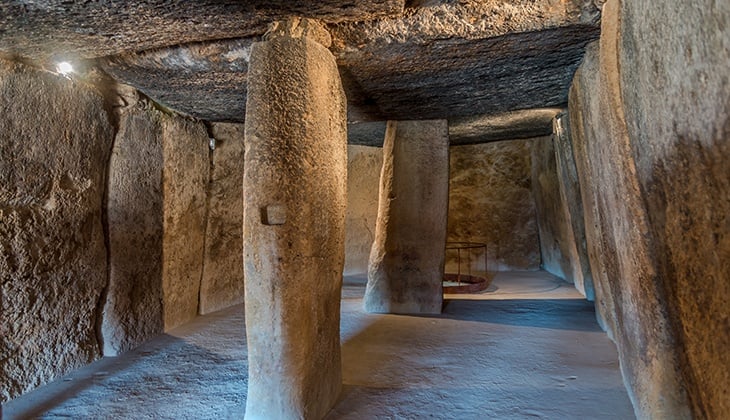Are you thinking about visiting Antequera? If you have been already there, as well as if you are planning to go, you may not miss this special corner. An authentic trip to pre-History, where you will feel like our ancestors 6,000 years ago. We are talking about El Sitio Dólmenes de Antequera, a cultural asset composed by three cultural monuments (Menga's Dolmen, Viera's Dolmen and El Romeral's Tholos) and two natural monuments (La Peña de los Enamorados and El Torcal), all of them declared UNESCO World Heritage Sites in 2016.
Menga's dolmen, the Europe's biggest one
The Menga's dolmen is the Europe's biggest megalithic settlement. More than 180-ton rocks covering a corridor, which ends up into a sepulchral chamber, since this is an huge burial pantheon. The dolmen was covered with soil, setting up an 164-feet-diameter artificial mountain, overtaking the famous Stonehenge.
A magical orientation
Most of the dolmens are facing the sun, as Viera's one does, pointed toward South east, from the sun light goes into the burial chamber during the two equinoxes, when the sun is over the earth's equator.
Menga and Romeral have unique orientations, since they don't point toward the sun, but to places which its builders were attracted by. The Menga's dolmen entry points toward Peña de los Enamorados, a mountain with an anthropomorphic shape only if you are looking at this from Archidona or the Antequera's dolmens hill. El Romeral's tholos, oriented to the west, points to the Sierra de El Torcal's carstic massif's highest peak, a place which was considered magical by the local communities.
Menga's dolmen, the only one with a well
Menga's dolmen is also the only one which has a well, the building of which is still a mystery. Discovered in 2005 through an 19-century-archaeologist's writings, it has the same depth as the burial chamber.
A hundreds people' work
A several years titanic work was needed to move the gigantic rocks. According to experts, they were hundreds of people, working perfectly synchronised and with the last techniques of the time, who build the dolmen. As they didn't still know the metal, they used boiling water and wood wedges to cut the rocks, and also to raise them by means of a pulleys and levers system.








